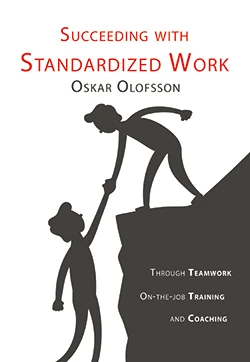 " height="250" width="800">
" height="250" width="800">
A young production manager speaks enthusiastically to the top management team. The young man just returned to the plant after attending an inspiring seminar. He is aware of the dilemma the company presently into and now he is convinced that they need to do something to correct the situation.
"We should implement Lean Production and TPM in our plant", he says. "This will make our production more reliable and increase our delivery accuracy".
The MD is paying attention but is not yet convinced. He wants to put the ideas to a test.
"Looks interesting," he says, "Please come back with a good calculation of the Return on Investment so that we can see if it fits into next year's budget."
This is where the story might end. How could you possible estimate costs and benefits from such advanced management techniques as TPM and Lean Manufacturing? These concepts are known to be difficult to plan in advance, and they require a total mind-shift for everybody in the facility.
Well, it may be difficult but you have to do the calculation anyway.
Arguments as "we have to do this" or "everybody else is doing it" are just not convincing enough. A change project must be looked upon as an investment that will come with initial costs and hopefully bring something back in return.
This is no different from any other investments. If you cannot give an educated guess on its financial impact, there is a big risk that the project might not be given the necessary resources for what it needs to succeed. Even if the financial impact of important factors such as shorter lead times and better delivery accuracy are not known, we need to describe how this project will raise profits in the company.
To give an answer to these important questions, we have put together some simple guidelines for you to use, and if you prefer, a free calculation tool that you may use to do your own estimations.What will the costs be?
The main cost will consist of:
• Training and Consultancy. No successful implementation of TPM and Lean Manufacturing has succeeded without the help of experienced professionals. You will have to train your employees and you need support in your project team. A good estimation is a yearly cost of $100,000 per 100 employees involved.
• Increased initial maintenance costs. Elimination of manufacturing waste and implementation of improvement ideas are likely to increase the maintenance costs. Expect maintenance to increase up to 20% during the first year, but even before the second year, maintenance costs will be lesser than what you have today when it eventually stabilizes at a certain level.
• Project team members. You will need people to run the project. Project management and coaching are equivalent to about one full-time coordinator per 100 employees in the facility.
• Benefits Increased. Overall Equipment Efficiency (OEE) is the main factor that may be used to approximate the return on the efforts. Simply speaking, the OEE is the ratio of the facility's actual output compared to the theoretical output that would be possible if the machinery was run at full speed every minute, without break-downs, lack of raw material, quality losses or set-ups. Since the OEE-ratio is a direct reflection of your plant's capacity, it may be used to calculate the future productivity after improvements. An example: A plant produces 10,000 units per year with an OEE-ratio of 50 percent. After improvement, the project team estimates that it will be possible to reach an OEE-ratio of 80 percent. This means that they will be capable to produce 10,000*80/50 = 16000 units in the same facility without investments and with the same manning as before.
• Can the increased capacity be used to increase sales? One important question is if there is a market for expansion. If so, the increased capacity may be used for increased sales. It is common that the company's market share might grow after implementing TPM or Lean Manufacturing. This is possible as improved delivery accuracy and shorter lead times make more sales possible even if the market is stagnant. If expansion is not considered possible, the increased capacity may instead be used to lower the production costs. This is possible through—less overtime, fewer shifts—fewer parallel production lines maintained and operated. The direct labor costs for production will therefore decrease as the OEE-ratio increases.
• Your present and future OEE-ratio. Do you know your plant's present OEE-ratio? If so, is it accurately calculated? Often we see that some downtimes are deducted when OEE is calculated. This might be "stops" for planned maintenance, set-up times, and lack of personnel. The end result will be an OEE-ratio that looks better than reality. If you do not know your present OEE-ratio, the easiest way to determine it is to use the free OEE Calculator link at our web site. Then estimate what you consider a possible OEE-ratio after improvements. World-Class companies reach 80-95% OEE. What is the realistic level for you? Use the present and future OEE to calculate the future benefits. If you don't want to do the calculations by hand, try instead the free ROI Calculator at our web site. Et voilà! You have your Return on Investment calculation to present to your stakeholders.
By Oskar Olofsson

Making lean work for you

World-Class / Lean Manufacturing

5S Implementation

SMED Quick Change-over

TPM and Plant Maintenance

Succeeding With Standardized Work

Succeeding With 5S